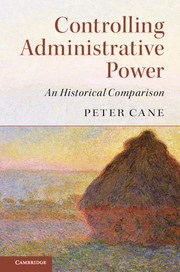Book contents
- Frontmatter
- Dedication
- Contents
- Preface
- Table of cases
- Table of legislation
- 1 Introduction: concepts and methodology
- 2 The English system of government
- 3 The US system of government
- 4 The Australian system of government
- 5 The development and institutional structure of control regimes
- 6 Administrative interpretation
- 7 Administrative fact-finding and policy-making
- 8 Administrative rule-making
- 9 Administrative adjudication
- 10 Private law controls
- 11 Controlling information
- 12 The New PublicManagement
- 13 Controlling the controllers
- 14 Concluding reflections on methodology and themes
- Bibliography
- Index
6 - Administrative interpretation
Published online by Cambridge University Press: 05 March 2016
- Frontmatter
- Dedication
- Contents
- Preface
- Table of cases
- Table of legislation
- 1 Introduction: concepts and methodology
- 2 The English system of government
- 3 The US system of government
- 4 The Australian system of government
- 5 The development and institutional structure of control regimes
- 6 Administrative interpretation
- 7 Administrative fact-finding and policy-making
- 8 Administrative rule-making
- 9 Administrative adjudication
- 10 Private law controls
- 11 Controlling information
- 12 The New PublicManagement
- 13 Controlling the controllers
- 14 Concluding reflections on methodology and themes
- Bibliography
- Index
Summary
Introduction
In Chapter 1, a ‘control regime’ was defined as a set of institutions, norms and practices for controlling public administrative power. Having surveyed the development and institutional structure of the systems of government and control regimes of the three jurisdictions being compared, the analysis now moves on to control norms. The most fundamental of those norms, common to all three systems, are (1) that administrators must comply with the law, and (2) that identifying the law authoritatively (or ‘conclusively’) is a characteristically judicial function. Although, framed at this level of abstraction, these two principles are found in each of the three systems being compared, there is (as we will see) a clear difference between the way they are implemented in the United States on the one hand, and in England and Australia on the other. The main task undertaken in this chapter is to explore and explain that difference.
First, something needs to be said about the concept of ‘law’. For the purposes of this study of control of public administrative power, law can be categorised as either ‘hard’ or ‘soft’. Soft law can be defined as norms addressed to administrators, which cannot directly affect the legal rights and obligations of citizens. In the American literature, such law is sometimes generically referred to as ‘the internal law of the administration’, or ‘non-legislative rules’ or even ‘administrative law’. The first of these phrases indicates that such law is addressed to administrators and is typically made by administrators. The second term contrasts soft law with rules made by administrators (‘administrative rules’) ‘whose legal effect is virtually identical to that of a statute’ and which, can therefore, affect the legal rights and obligations of citizens. Hard law can be sorted into four categories: (1) ‘higher’ law; (2) ‘primary’ legislation (statute law); (3) ‘secondary’ or ‘delegated’ legislation (legislative rules); and (4) common (judge-made) law. Secondary legislation can be defined as law made by an administrator in exercise of a power to make hard law, conferred by primary legislation. By contrast, soft law is typically law generated as a (by-)product of the exercise of a statutory power other than a power to make hard law: for instance, a power to determine the rights and obligations of an individual by applying (or implementing) hard law, or an express or implied power to make rules addressed to administrators.
- Type
- Chapter
- Information
- Controlling Administrative PowerAn Historical Comparison, pp. 203 - 237Publisher: Cambridge University PressPrint publication year: 2016
- 1
- Cited by

